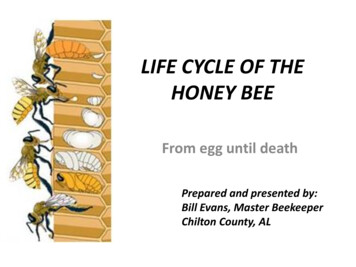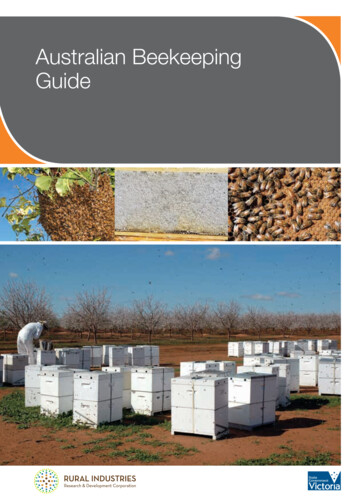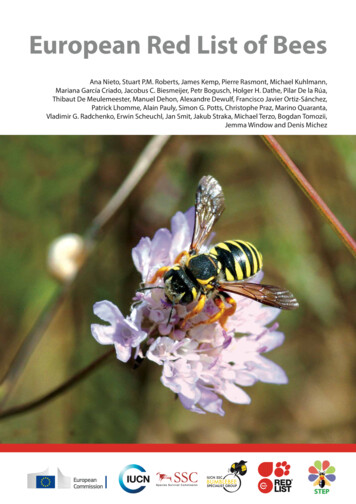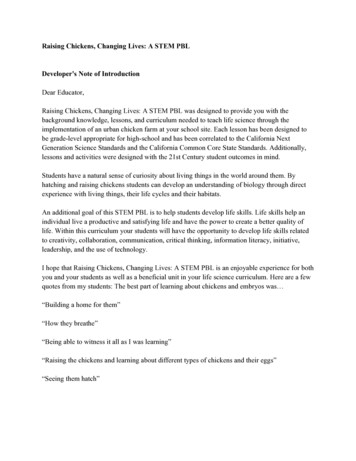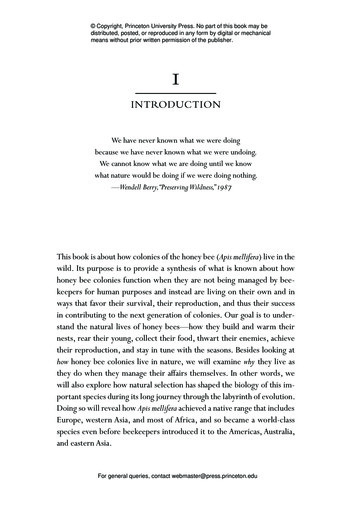
Transcription
Copyright, Princeton University Press. No part of this book may bedistributed, posted, or reproduced in any form by digital or mechanicalmeans without prior written permission of the publisher.1INTRODUCTIONWe have never known what we were doingbecause we have never known what we were undoing.We cannot know what we are doing until we knowwhat nature would be doing if we were doing nothing.—Wendell Berry,“Preserving Wildness,” 1987This book is about how colonies of the honey bee (Apis mellifera) live in thewild. Its purpose is to provide a synthesis of what is known about howhoney bee colonies function when they are not being managed by bee keepers for human purposes and instead are living on their own and inways that favor their survival, their reproduction, and thus their successin contributing to the next generation of colonies. Our goal is to understand the natural lives of honey bees—how they build and warm theirnests, rear their young, collect their food, thwart their enemies, achievetheir reproduction, and stay in tune with the seasons. Besides looking athow honey bee colonies live in nature, we will examine why they live asthey do when they manage their affairs themselves. In other words, wewill also explore how natural selection has shaped the biology of this important species during its long journey through the labyrinth of evolution.Doing so will reveal how Apis mellifera achieved a native range that includesEurope, western Asia, and most of Africa, and so became a world- classspecies even before beekeepers introduced it to the Americas, Australia,and eastern Asia.For general queries, contact webmaster@press.princeton.eduSeeley.indb 12/21/2019 8:07:08 AM
Copyright, Princeton University Press. No part of this book may bedistributed, posted, or reproduced in any form by digital or mechanicalmeans without prior written permission of the publisher.2Chapter 1Knowing how the honey bee lives in its natural world is important fora broad range of scientific studies. This is because Apis mellifera has becomeone of the model systems for investigating basic questions in biology, especially those related to behavior. Whether one is studying these bees tosolve some mystery in animal cognition, behavioral genetics, or social behavior, it is critically important to become familiar with their natural biology before designing one’s experimental investigations. For example,when sleep researchers used honey bees to explore the functions of sleep,they benefited greatly from knowing that it is only the elderly bees withina colony, the foragers, that get most of their sleep at night and in comparatively long bouts. If these researchers had not known which bees are acolony’s soundest sleepers come nightfall, then they might have failed todesign truly meaningful sleep- deprivation experiments. A good experiment with honey bees, as with all organisms, taps into their natural wayof life.Knowing how honey bee colonies function when they live in the wildis also important for improving the craft of beekeeping. Once we understand the natural lives of honey bees, we can see more clearly how wecreate stressful living conditions for these bees when we manage themintensively for honey production and crop pollination. We can then startto devise beekeeping practices that are better—for both the bees and ourselves. The importance of using nature as a guide for developing sustainable methods of agriculture was expressed beautifully by the author, environmentalist, and farmer Wendell Berry, when he wrote: “We cannotknow what we are doing until we know what nature would be doing if wewere doing nothing.”The current state of beekeeping shows us all too clearly how problemsin the lives of animals under our management can arise when we fail toconsider how they would be living if we were not forcing them to live inartificial ways that serve mainly our own interests. Many beekeepers— especially those in North America who practice industrial- scale beekeeping with tens of thousands of colonies of Apis mellifera, the species that isthe focus of this book—are experiencing colony mortality rates of 40For general queries, contact webmaster@press.princeton.eduSeeley.indb 22/21/2019 8:07:08 AM
Copyright, Princeton University Press. No part of this book may bedistributed, posted, or reproduced in any form by digital or mechanicalmeans without prior written permission of the publisher.Introduction3percent or more each year.To be sure, this is not due entirely to the colonymanagement practices of beekeepers. Changes in the crop productionpractices of farmers, especially the use of systemic insecticides that areabsorbed by plants and contaminate their nectar and pollen, and the switchin many places to growing corn and soybeans instead of clover and alfalfa,also play roles in this sad story. But the heavy- handed manipulations of thelives of the honey bee colonies housed in beekeepers’ hives certainly docontribute to the sky- high rates of colony mortality.We will see that whenbeekeepers force colonies to live crowded together in apiaries—wherethe bees’ homes are less than 1 meter (ca. 3 feet) apart, rather than thehundreds of meters (at least 1,000 feet) apart in nature—beekeepersboost the efficiency of their work but they also foster the spread of thebees’ diseases. Likewise, when beekeepers supersize their colonies byhousing them in huge hives that are nearly as tall as themselves, rather thanin smaller hives the size of the bees’ natural nesting cavities, they boost thehoney production of their colonies, but they also turn them into stupendous hosts for the pathogens and parasites of Apis mellifera, such as thedeadly ectoparasitic mite Varroa destructor.Given the harmful effects on the bees that arise from the standard practices of beekeeping, it is not surprising that many beekeepers are nowexploring alternative approaches to this craft. These folks are keen to usenature as a model, and this requires a solid understanding of how honeybees live on their own in nature. To help readers who want to adjust theirbeekeeping practices to make them more bee- friendly, I have included afinal chapter on what I like to call “Darwinian beekeeping,” which is anapproach to beekeeping that aims to give bees the opportunity to live theway they do in the wild.FOCUS ON WILD COLONIES IN THENORTHEASTERN UNITED STATESThis book does not attempt to provide a comprehensive account of howApis mellifera lives in nature across its vast geographic range, which nowincludes Europe, some of Asia, all of Africa except the great desert regions,For general queries, contact webmaster@press.princeton.eduSeeley.indb 32/21/2019 8:07:08 AM
Copyright, Princeton University Press. No part of this book may bedistributed, posted, or reproduced in any form by digital or mechanicalmeans without prior written permission of the publisher.4Chapter 1Fig. 1.1. Left: Bee- tree home of a wild colonyof honey bees living in the Arnot Forest, ofCornell University, in the United States. Redarrow indicates the small knothole entranceof this colony’s nest. Right: Nest entrance of awild colony of honey bees living in Munich,Germany.For general queries, contact webmaster@press.princeton.eduSeeley.indb 42/21/2019 8:07:10 AM
Copyright, Princeton University Press. No part of this book may bedistributed, posted, or reproduced in any form by digital or mechanicalmeans without prior written permission of the publisher.Introduction5most of North and South America, and parts of Australia and New Zealand. Instead, it focuses on how colonies of our most important pollinatorare living in the wild in the deciduous forests of the northeastern UnitedStates, a place where they have thrived as an introduced species for nearly400 years.This is also the place where, for more than 40 years, my collaborators and I have studied the behavior, social life, and ecology of honey beesliving in the wild (Fig. 1.1). Although our studies are based on honey beesliving outside their native range, I believe that what we have learned abouthow honey bees live in the woods in the northeastern corner of the UnitedStates can help us understand how these bees originally lived in nature inEurope, especially in its northern and western regions.Until the mid- 1800s, all the honey bees living in the northeasternUnited States were descendants of the colonies of honey bees that werebrought to North America from northern Europe starting in the early1600s. Insect taxonomists recognize some 30 subspecies (geographic variants) of Apis mellifera, and they refer to the honey bees native to northernEurope as members of the subspecies Apis mellifera mellifera Linnaeus. Thissubspecies of Apis mellifera—also called the dark European honey bee—hasthe distinction of being the first kind of honey bee to be described taxonomically. This was done 360 years ago, in 1758, when Carl Linnaeus, aprofessor of botany and zoology at Uppsala University in Sweden, published his work Systema Naturae, in which he presented the system of taxonomic classification that biologists have used ever since.The dark European honey bee is so named because its body color rangesfrom dark brown to jet black and historically it lived throughout northernEurope, from the British Isles in the west to the Ural Mountains in the east,and from the Pyrenees and Alps in the south to the coasts of the Baltic Seain the north (Fig. 1.2). We know from archaeological studies, which havefound traces of beeswax in fragments of pottery vessels dating from 7,200to 7,500 years before present, that this bee was living in Germany andAustria some 8,000 years ago. We also know from genetic studies of thebees themselves that as the climate of northern Europe underwent postglacial warming, starting about 10,000 years ago, this bee expanded itsFor general queries, contact webmaster@press.princeton.eduSeeley.indb 52/21/2019 8:07:10 AM
Copyright, Princeton University Press. No part of this book may bedistributed, posted, or reproduced in any form by digital or mechanicalmeans without prior written permission of the publisher.6Chapter 1ArcticCirclealUr60 .MtOsloMoscowLondonBerlinibericaren.sli g u40 icstMadridCaucasus Mt.carnicacaucasicaic aPyViennaAlpsonParisrallifemeamacedIstanbulFig. 1.2. Distribution map of the dark European honey bee, Apis mellifera mellifera.Green line: original distribution limits to the west, north, and east. Verticallyhatched line: transition zone to the honey bee races of southern and easternEurope (A. m. ligustica, carnica, macedonica, and caucasica). Red dashed line: northern limit of beekeeping.range north and east from Ice Age refugia—pockets of woodlands in themountains of southern France and Spain—as it tracked the expansion offorests populated with thermophilic trees such as willow, hazel, oak, andbeech. Evidently, Apis mellifera mellifera flourished as it spread and eventually extended its range farther north within Europe than any other subspecies, drawing on the adaptations for winter survival that it had evolvedduring the glacial period. It is estimated that within the eastern, heavilyforested two- thirds of its range (from eastern Germany to the Urals) thereonce lived millions of colonies of the dark European honey bee. And thereis no doubt that tree beekeeping—cutting cavities in trees to create nestsites and then harvesting honey without killing the colonies living in theFor general queries, contact webmaster@press.princeton.eduSeeley.indb 62/21/2019 8:07:10 AM
Copyright, Princeton University Press. No part of this book may bedistributed, posted, or reproduced in any form by digital or mechanicalmeans without prior written permission of the publisher.Introduction7artificial hollows—provided most of the beeswax and honey traded inEurope in the Middle Ages. A vestige of this centuries- old tradition of treebeekeeping is found in the South Ural region of the republic of Bashkortostan, part of the Russian Federation. Colonies of pure A. m. mellifera stillinhabit the forests of this region, and Bashkir tree- hive beekeepers stillharvest basswood (Tilia cordata) honey from colonies residing in man- made nest cavities high in the trees.The dark European honey bee is superbly adapted to living in forestedregions with relatively cool summers and long, cold winters. It is not surprising, therefore, that when bees of this subspecies were brought to Massachusetts, Delaware, and Virginia in North America by English and Swedish immigrants starting in the early 1600s, they escaped (swarmed) fromthe beekeepers’ hives and soon became an important part of the localfauna. Already in 1720, a Mr. Paul Dudley published, in PhilosophicalTransactions, a journal of the Royal Society of London, a letter titled “Anaccount of a method lately found out in New- England for discoveringwhere the bees hive in the woods, in order to get their honey.” Analysis ofletters, diaries, and accounts of travels in North America written in the1600s and 1700s has revealed that these honey bees spread speedily acrossthe heavily forested eastern half of North America below the Great Lakes(Fig. 1.3). Also, the journals of the Lewis and Clark Expedition documentthe dark European honey bee’s rapid colonization of North America eastof the Mississippi River. For example, on Sunday, 25 March 1804, shortlyafter the expedition party had left St. Louis and was camped along theKansas River, William Clark wrote in his journal: “River rose 14 Inch lastnight, the men find numbers of Bee Trees, & take great quantities of honey.”These days, the honey bees living wild in the forests of the northeasternUnited States are no longer a genetically pure population of Apis melliferamellifera. This is because, in 1859, following the advent of steamship service between Europe and the United States, American beekeepers beganimporting queen bees of several other subspecies of Apis mellifera, ones thatare native to southern Europe or northern Africa. These imports continued for more than 60 years, during which time many thousands of matedFor general queries, contact webmaster@press.princeton.eduSeeley.indb 72/21/2019 8:07:10 AM
Copyright, Princeton University Press. No part of this book may bedistributed, posted, or reproduced in any form by digital or mechanicalmeans without prior written permission of the publisher.8Chapter 145 N17941790Chicago1644182616981796BostonNew York164040 N1655179217801622Norfolk178835 N17501796179630 N17361770New Orleans17651773MiamiFig. 1.3. The dispersal of the dark European honey bee across eastern NorthAmerica following introductions (indicated by solid arrows) in Virginia, Massachusetts, Connecticut, and Maryland in the 1600s, and in Alabama in 1773.Dashed arrows indicate the bee’s subsequent spread.queen bees were shipped to North America, but they abruptly ceased in1922. This was the year the U.S. Congress passed the Honey Bee Act,which prohibited further imports to protect honey bees in the UnitedStates from the Isle of Wight disease, an unspecific but supposedly highlyinfectious and lethal disease named for the location of its first reputedFor general queries, contact webmaster@press.princeton.eduSeeley.indb 82/21/2019 8:07:10 AM
Copyright, Princeton University Press. No part of this book may bedistributed, posted, or reproduced in any form by digital or mechanicalmeans without prior written permission of the publisher.Introduction9outbreak, in southern England. As we shall see, the genetic compositionof the wild honey bees living in the northeastern United States is now ablend of the genes of A. m. mellifera and several other subspecies of Apismellifera. Of those introduced in the late 1800s and early 1900s, the threemost important all came from south- central Europe: A. m. ligustica (fromItaly), A. m. carnica (from Slovenia), and A. m. caucasica (from the CaucasusMountains). Several other subspecies were introduced from the MiddleEast and Africa—A. m. lamarckii (from Egypt), A. m. cypria (from Cyprus),A. m. syriaca (from Syria and the eastern Mediterranean region), andA. m. intermissa (from northern Africa)—but they did not prove popular,and it seems that they are not well represented genetically anywhere in theUnited States.More recently, in 1987, a subspecies of Apis mellifera that is native toeastern and southern Africa, A. m. scutellata, entered the southern UnitedStates by way of Florida, perhaps when a beekeeper, seeking bees thatwould thrive in subtropical Florida, smuggled in some queens of this tropically adapted subspecies. Since then, colonies of A. m. scutellata have indeed thrived in Florida and have greatly influenced the genetics of thehoney bees living in the southeastern United States but not of the honeybees living in the northeastern United States, probably because coloniesof A. m. scutellata cannot survive northern winters. Bees of the Africansubspecies A. m. scutellata entered the United States a second time and in asecond place in 1990, when swarms flew across the U.S.–Mexico borderinto Texas. Here again they mixed with the European honey bees alreadyin residence. Since then, populations of colonies that are hybrids of Africanand European honey bees (so- called Africanized honey bees) have developed in the humid, subtropical parts of southern Texas and in the southernmost parts of New Mexico, Arizona, and California. As of 2013, thegene pool of the Africanized bees in southern Texas still had a small geneticcontribution (ca. 10%, for both mitochondrial and nuclear genes) fromEuropean honey bees.The complex history of countless introductions to North America ofhoney bees from various regions of Europe, the Middle East, and AfricaFor general queries, contact webmaster@press.princeton.eduSeeley.indb 92/21/2019 8:07:10 AM
Copyright, Princeton University Press. No part of this book may bedistributed, posted, or reproduced in any form by digital or mechanicalmeans without prior written permission of the publisher.10Chapter 1raises an important question:What is the mix of subspecies of Apis melliferain the wild colonies living in the northeastern United States, the mainsubjects of this book? Fortunately, we now have a clear answer to this question for the colonies living in the vast woodlands of southern New YorkState. In 1977 and then again in 2011, I collected worker bees from 32wild colonies living in this heavily forested region.The 32 sets of bees from1977 were stored as pinned (voucher) specimens in the Cornell UniversityInsect Collection, and the 32 sets of bees from 2011 were stored in vialsfilled with ethanol, which preserves DNA quite nicely. In 2012, specimensfrom both groups of bees were shipped to one of my former students,Professor Alexander S. Mikheyev, who heads the Ecology and EvolutionUnit at the Okinawa Institute of Science and Technology in Japan. Therethe DNA was extracted from one bee from each of the 64 colonies that Ihad sampled and an analysis based on whole- genome sequencing was performed to determine the subspecies composition of both the 1977 (“old”)and the 2011 (“modern”) populations of bees (Fig. 1.4).This genetic detective work found that the bees in both the old andmodern samples are primarily descendants of two of the subspecies of Apismellifera that were imported from southern Europe, specifically from Italyand from Slovenia: A. m. ligustica and A. m. carnica, respectively.This findingwas not surprising, because these are the two subspecies that have proventhe most popular among beekeepers in North America since the 1800s.Colonies of these two subspecies tend to be good- natured (not prone tostinging) and good producers of honey.What was surprising, however, wasthe discovery that the bees in both the old and modern samples also possessed many genes from the dark honey bees imported from north of theAlps (A. m. mellifera) starting in the 1600s and from the gray mountainhoney bees (A. m. caucasica) imported from the Caucasus Mountains starting in the late 1800s (see Fig. 1.4).This genetic sleuthing also revealed thatthe bees in the modern (2011) sample, but not those in the old (1977)sample, have a small percentage (less than 1%) of genes from two Africansubspecies: A. m. scutellata, native to Africa south of the Sahara, and A. m.yemenetica, native to the hot arid zones of Arabia (e.g., Saudi Arabia,Yemen,For general queries, contact webmaster@press.princeton.eduSeeley.indb 102/21/2019 8:07:10 AM
Copyright, Princeton University Press. No part of this book may bedistributed, posted, or reproduced in any form by digital or mechanicalmeans without prior written permission of the publisher.11OldProportion of ancestral feracaucasicascutellatayemeneticaFig. 1.4. Ancestries of the honey bees (Apis mellifera) living in the forests southof Ithaca, New York. Both the old (1970s) and the modern (2010s) populationsare largely descendants of bees from southern and southeastern Europe: thesubspecies A. m. ligustica, carnica, and caucasica, which have been popular withbeekeepers in North America since the 1880s. Both old and modern populationsalso have clear ancestry from the dark European honey bees (A. m. mellifera) ofnorthern Europe that were introduced to North America starting in the 1600s.The modern population also shows a small ancestry of bees from Africa (A. m.scutellata) and the Arabian peninsula (A. m. yemenitica).and Oman) and eastern Africa (e.g., Sudan, Somalia, and Chad).This slightintrogression of African genes into the modern population of wild coloniesliving in the forests near Ithaca, New York, is probably a result of Africanized honey bees—hybrids of African and European races of Apis mellifera—becoming established in parts of the southern United States in the late1980s and early 1990s. These southern regions—which include the statesof Florida, Georgia, Alabama, and Texas—have warm climates favorableto Africanized honey bees, and they are where much of the commercialqueen production in the United States takes place. Evidently, for the lastFor general queries, contact webmaster@press.princeton.eduSeeley.indb 112/21/2019 8:07:10 AM
Copyright, Princeton University Press. No part of this book may bedistributed, posted, or reproduced in any form by digital or mechanicalmeans without prior written permission of the publisher.12Chapter 125 or so years, queen producers in the southern states have been shippingqueens carrying some genes of African descent to beekeepers in the northern states. Migratory beekeepers who keep their colonies in Florida overwinter and then truck them north in spring to pollinate apples, cranberries, and other crops, have probably also contributed to the northwardtrickle of genes of the Africanized honey bees.This new, high- tech look at the genes of the honey bees living in thewoodlands south of Ithaca has revealed two important things. First, it hasshown us that the arrivals of African honey bees in Florida and Texas in the1980s and 1990s have affected only very slightly the genetic compositionof the wild colonies living in the forests near Ithaca. In other words, thegenetic makeup of these wild colonies still reflects mainly the nearly 400- year history of imports of honey bees from Europe. Second, it shows thatthe genes in this population of wild colonies have come predominantlyfrom honey bees native to southern Europe, even though the introductionsof honey bees from northern Europe started some 200 years earlier. Presumably, this reflects the greater popularity among beekeepers of beesfrom Italy and Slovenia (A. m. ligustica and A. m. carnica), in southern Europe, relative to the dark European honey bees (A. m. mellifera) from various places in northern Europe. Most beekeepers prefer bees that are calmand produce much honey, and the lighter- colored bees of southern Europe, compared to the darker- colored bees of northern Europe, tend tobe less likely to run around when a hive is opened and more likely to buildup large populations of worker bees and amass large stores of honey.Given that most of the genes in the wild colonies living near Ithaca arefrom honey bees adapted to the relatively mild climates of southern Europe, and given that Ithaca winters are long, snowy (Fig. 1.5), and oftenbitterly cold (lowest temperatures about 23 C/ 10 F), we need to ask:Are the wild honey bees living near the Ithaca area well adapted for life inthis northern region of North America? We will see in the coming chaptersthat the answer to this question is a solid yes; multiple studies have foundthat the wild colonies of honey bees living in this region are impressivelyskilled at living here. These studies have looked at how the colonies’ nest- For general queries, contact webmaster@press.princeton.eduSeeley.indb 122/21/2019 8:07:10 AM
Copyright, Princeton University Press. No part of this book may bedistributed, posted, or reproduced in any form by digital or mechanicalmeans without prior written permission of the publisher.Introduction13Fig. 1.5.Winter look of an apiary located in Ellis Hollow, near Ithaca, NewYork.site preferences, seasonal patterns of brood rearing and swarming, foraging skills, overwintering abilities, and defenses against pathogens and parasites are all highly adaptive for life in this northeastern corner of theUnited States. Perhaps the most compelling indication that these wildcolonies are well adapted to their current environment is that they possessa powerful set of behavioral defenses against the aptly named ectoparasiticmite Varroa destructor. In chapter 10, we will see how the population ofwild colonies living near Ithaca was decimated when this mite—whoseoriginal host is an Asian honey bee species, Apis cerana—reached the Ithacaarea in the mid- 1990s but then recovered through strong selection formultiple defensive behaviors in worker bees that kill these mites. Indeed,we now know that the density of wild colonies of honey bees in the 2010s(ca. 20 years post- Varroa arrival) matches what it was in the 1970s (ca. 20years pre- Varroa arrival).We should not be surprised that the wild colonies of honey bees livingin the forests around Ithaca are well adapted to survive and reproduce inFor general queries, contact webmaster@press.princeton.eduSeeley.indb 132/21/2019 8:07:11 AM
Copyright, Princeton University Press. No part of this book may bedistributed, posted, or reproduced in any form by digital or mechanicalmeans without prior written permission of the publisher.14Chapter 1these northern woodlands, where the winters are far longer and colderthan the winters in many of the bees’ ancestral homelands in Europe. Afterall, these colonies have been exposed to strong natural selection to adaptto the climate throughout their nearly 400- year history of living in thenortheastern United States, and there are countless studies by biologiststhat demonstrate that evolution by natural selection can produce a population of plants or animals with a robust solution to a new problem in justa few years. Besides the rapid evolution of Varroa resistance in the wildcolonies of honey bees living in the forests around Ithaca, there is theexample of the Africanized honey bees (Apis mellifera scutellata) in PuertoRico evolving docility in only 10 or so years. Evidently, this rapid evolutionary change, which occurred between 1994 and 2006, was driven bynatural selection favoring genes for reduced aggression in honey beesliving where there are no major predators. Another striking example ofan insect’s rapid behavioral adaptation to a changed circumstance is theadaptive disappearance between the late 1990s and 2003 of the callingsong of male field crickets (Teleogryllus oceanicus) on the Hawaiian islandof Kauai. This behavioral change followed the accidental introduction ofparasitic flies that locate host crickets by orienting to the crickets’ chirps.Male crickets with mutations for wing structures that silenced their singing were strongly favored by natural selection. Quick evolution led toquiet crickets!ROAD MAP TO WHAT FOLLOWSThis book aims to provide you with a clear view of the natural lives ofhoney bee colonies, especially those living in cold climate regions of theworld. To enjoy this view, you will need to work your way through somenew scientific terrain, make dozens of stops along the way, and look carefully in a different direction at each stopping place.You will soon see thatthis book is partly a synthesis of the work of many research biologists andpartly a travelogue of my personal quest to better understand this specialpiece of nature. Here is a road map to what follows.For general queries, contact webmaster@press.princeton.eduSeeley.indb 142/21/2019 8:07:11 AM
Copyright, Princeton University Press. No part of this book may bedistributed, posted, or reproduced in any form by digital or mechanicalmeans without prior written permission of the publisher.Introduction15Chapter 2 describes when, where, and how I became intrigued with thepuzzle of how colonies of the “domestic” honey bee, Apis mellifera, live inthe wild.This chapter introduces you to the landscape and forests south ofthe small city of Ithaca, in central NewYork State, which is where many ofthe investigations described in this book were conducted. It also describeshow, in the late 1970s, I began studying the population of wild coloniesliving in one of these forests, the Arnot Forest. It further describes how,in the early 2000s, I was amazed to find wild colonies still living in thisforest even though the deadly ectoparasitic mite Varroa destructor had spreadto the Ithaca area sometime in the early 1990s. This chapter goes on toreview what we know about the abundance (and persistence) of wild colonies of Apis mellifera in other places. By the end of chapter 2, you will seeclearly the two main puzzles that are solved, step- by- step, in the rest ofthe
rators and I have studied the behavior, social life, and ecology of honey bees living in the wild (Fig. 1.1). Although our studies are based on honey bees living outside their native range, I believe that what we have learned about how honey bees l
